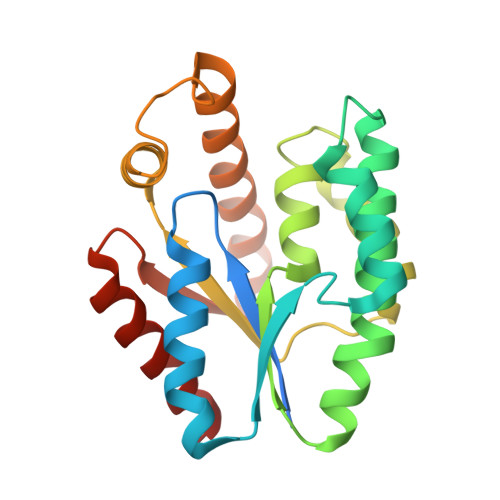Structures of S. Aureus Thymidylate Kinase Reveal an Atypical Active Site Configuration and an Intermediate Conformational State Upon Substrate Binding
Kotaka, M., Dhaliwal, B., Ren, J., Nichols, C.E., Angell, R., Lockyer, M., Hawkins, A.R., Stammers, D.K.(2006) Protein Sci 15: 774
- PubMed: 16522804
- DOI: https://doi.org/10.1110/ps.052002406
- Primary Citation of Related Structures:
2CCG, 2CCJ, 2CCK - PubMed Abstract:
Methicillin-resistant Staphylococcus aureus (MRSA) poses a major threat to human health, particularly through hospital acquired infection. The spread of MRSA means that novel targets are required to develop potential inhibitors to combat infections caused by such drug-resistant bacteria. Thymidylate kinase (TMK) is attractive as an antibacterial target as it is essential for providing components for DNA synthesis. Here, we report crystal structures of unliganded and thymidylate-bound forms of S. aureus thymidylate kinase (SaTMK). His-tagged and untagged SaTMK crystallize with differing lattice packing and show variations in conformational states for unliganded and thymidylate (TMP) bound forms. In addition to open and closed forms of SaTMK, an intermediate conformation in TMP binding is observed, in which the site is partially closed. Analysis of these structures indicates a sequence of events upon TMP binding, with helix alpha3 shifting position initially, followed by movement of alpha2 to close the substrate site. In addition, we observe significant conformational differences in the TMP-binding site in SaTMK as compared to available TMK structures from other bacterial species, Escherichia coli and Mycobacterium tuberculosis as well as human TMK. In SaTMK, Arg 48 is situated at the base of the TMP-binding site, close to the thymine ring, whereas a cis-proline occupies the equivalent position in other TMKs. The observed TMK structural differences mean that design of compounds highly specific for the S. aureus enzyme looks possible; such inhibitors could minimize the transfer of drug resistance between different bacterial species.
Organizational Affiliation:
Division of Structural Biology, The Wellcome Trust Centre for Human Genetics, University of Oxford, Oxford OX3 7BN, United Kingdom.















